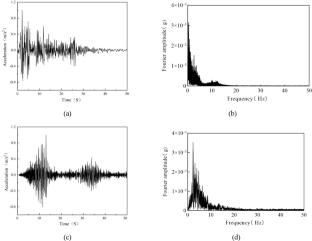Shaking table model tests of the dynamic response of a homogeneous rock slope under strong earthquake conditions
Abstract
The dynamic stability of slopes is a prominent problem in China. The shaking table model test of a homogeneous slope was designed based on the Shazipo granite landslide caused by the 5.12 Wenchuan earthquake. The results show that the acceleration amplification factor of the slope increases significantly with increasing elevation and decreasing distance from the slope surface. The acceleration amplification factor of the slope under sine wave loading is higher than that under natural seismic wave loading, and the acceleration response of the Wolong wave is stronger than that of the El-Centro wave. With increasing seismic wave amplitude and frequency, the acceleration amplification factor of the slope first increases and then decreases. Under the loading of input waves with acceleration amplitudes of 0.3–0.6 g, the slope damping ratio continuously increases and the slope damage gradually accumulates. Under input wave loading with an acceleration amplitude of 0.7 g, the slope experiences sliding failure, the natural vibration frequency of the slope decreases obviously, and the damping ratio increases significantly. The failure modes of the homogeneous slope are as follows: small cracks appear at the shoulder and foot of the slope; cracks appear in the shallow surface and continue to develop and extend; cracks occur at the shoulder and increase in the slope body; and large-scale sliding failure occurs at the top of the slope. The experimental results can provide a theoretical basis and guidance for the dynamic protection of homogeneous rock slopes in strong earthquake areas.


 求助内容:
求助内容: 应助结果提醒方式:
应助结果提醒方式:


